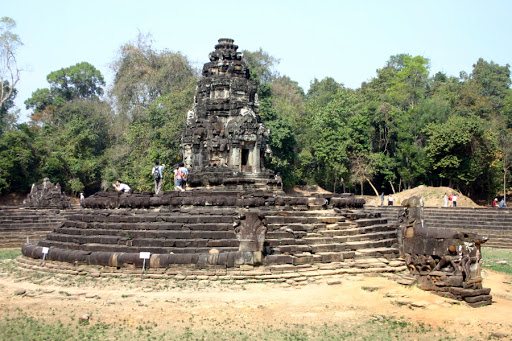Neak Poun Buddhist temple, Cambodia

Address
Neak Poun Buddhist temple Krong Siem Reap, Cambodia
Diety
Lokeshvara( Buddha)
Introduction
Neak Pean at Angkor, Cambodia is an artificial island with a Buddhist temple on a circular island in Jayatataka Baray, which was associated with Preah Khan temple, built during the reign of King Jayavarman VI. The temple area on the island in the center of the Jayatataka baray is enclosed by a square laterite wall measuring 350 meters wide, in which were contained a number of ponds. While the outer ponds have gone, the central pond and four surrounding ponds remain. The central pond of Neak Pean symbolizes lake Anavatapta, a lake located in the center of the world in Buddhist cosmology. At each of its four sides is a smaller pond and a chapel connecting the large central pond with the surrounding ones. In each chapel there is a stone gargoyle in a different shape, namely a head of a King, an elephant, a lion and a horse. Through their open mouths flowed water that filled that chapel’s small basins with the healing waters from the central pool. Each of the chapels contains a base, on which the main idol stood. Several depictions of Lokeshvara can be found inside the chapels.
Puranic Significance
In the center of the central pond is a circular island with a diameter of 14 meters, on which stands the sanctuary. The sandstone sanctuary is set on a circular stone base, encircled by two Naga snakes, guarding the East entrance of the temple. At the other end their tales intertwine, from which the temple derives its name; Neak Pean translates to “the entwined snakes”.Originally the sanctuary had doors on each of the four cardinal directions. At one point three of them were closed, leaving just the East entrance. The false doors were adorned with large carved depictions of Lokeshvara, believed to posses the powers of healing. On the pediment over the East entrance is a depiction of the Buddha. The image of the Buddha that was enshrined inside the sanctuary is no longer there. Scattered around the central sanctuary are several lingas (the representation of Shiva), and Yonis (the female counterpart of the linga). In front of the East entrance stands a statue of the flying horse Balaha, often partly submerged in the rainy season.
Century/Period/Age
Second half of the 12th century
Managed By
UNESCO World Heritage Site
Nearest Bus Station
Krong Siem Reap
Nearest Railway Station
Cambodia
Nearest Airport
Siem Reap International Airport









